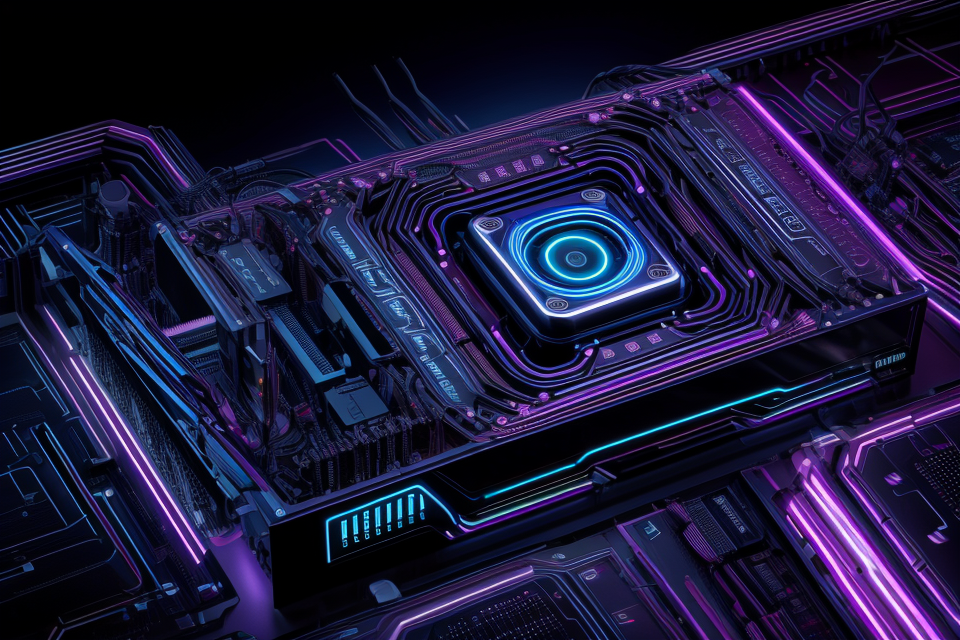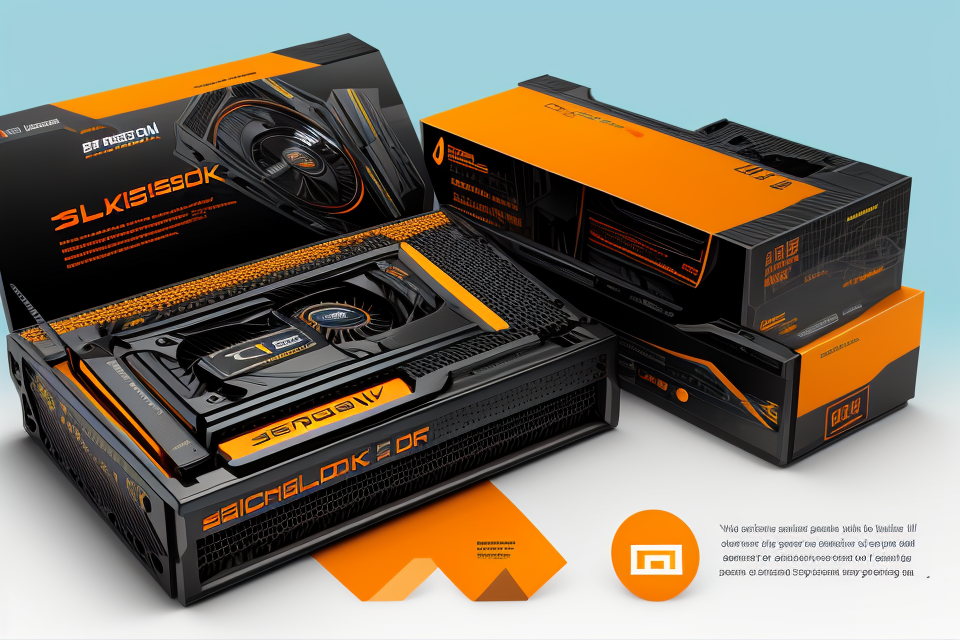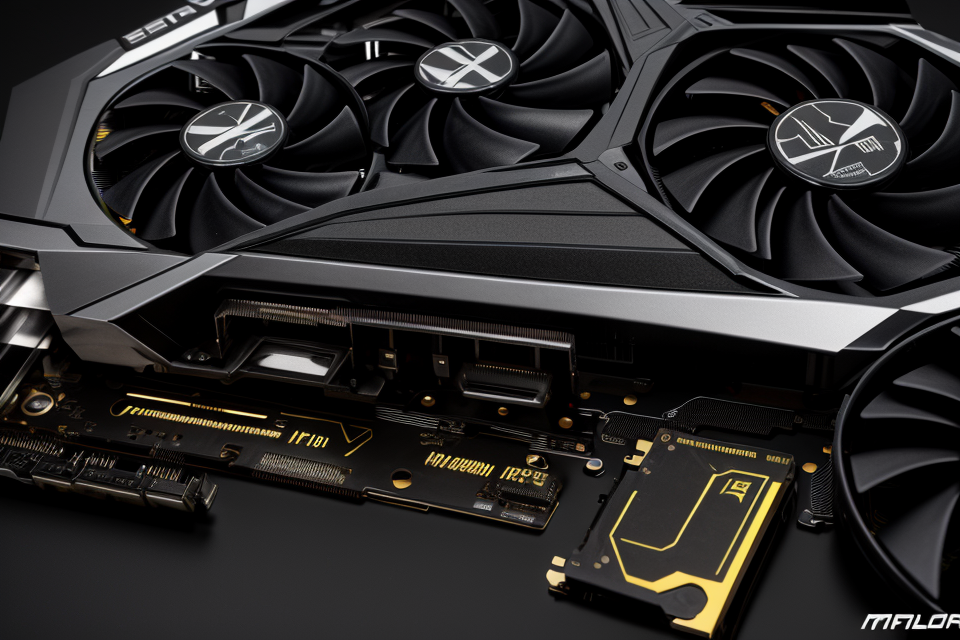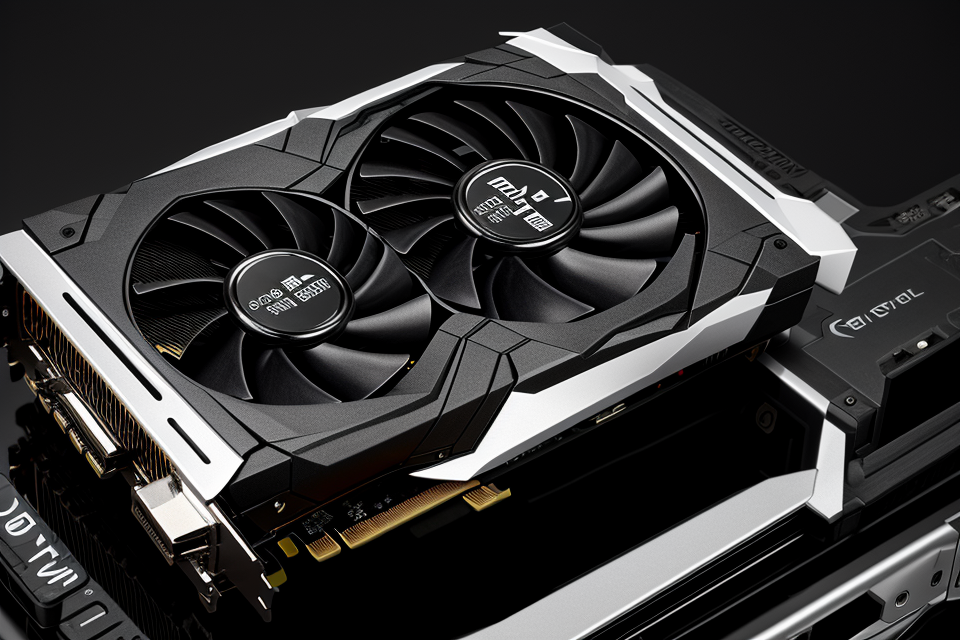
Graphics Processing Units (GPUs) have revolutionized the world of computing, transforming everything from gaming to scientific research. But what makes a GPU different from a traditional CPU? In this article, we’ll explore the key features that set GPUs apart and make them such powerful tools for a wide range of applications. From parallel processing to massive memory banks, we’ll take a deep dive into the capabilities of GPUs and see why they’re such an essential part of modern computing. So buckle up and get ready to discover the magic behind these incredible processors!
Understanding Graphics Processing Units (GPUs)
What is a GPU?
A graphics processing unit (GPU) is a specialized electronic circuit designed to rapidly manipulate and alter memory to accelerate the creation of images in a frame buffer intended for output to a display device. In simpler terms, a GPU is a dedicated hardware component that is specifically designed to handle the complex mathematical calculations required for rendering images and animations on various devices.
GPUs are used in a wide range of applications, including embedded systems, mobile phones, personal computers, workstations, and game consoles. They are particularly well-suited for tasks that require intensive computation, such as gaming, video editing, and scientific simulations.
One of the key advantages of GPUs is their ability to perform multiple calculations simultaneously, thanks to their parallel processing architecture. This allows them to handle large amounts of data quickly and efficiently, making them an essential component in many modern computing systems.
Another important feature of GPUs is their programmability. Unlike traditional graphics chips, which are designed to perform a specific set of tasks, GPUs can be programmed to perform a wide range of operations. This flexibility makes them a valuable tool for developers, who can use them to create custom applications and algorithms tailored to their specific needs.
Overall, the combination of parallel processing and programmability makes GPUs a powerful tool for a wide range of applications, from gaming and entertainment to scientific research and data analysis.
GPU vs. CPU
While both a central processing unit (CPU) and a graphics processing unit (GPU) are crucial components of a computer, they have distinct differences in terms of their architecture and intended purposes.
Architecture
A CPU is typically composed of a few powerful cores that are designed to handle a wide range of tasks, including processing data, executing instructions, and managing system operations. On the other hand, a GPU has a much larger number of smaller cores that are specialized for processing and rendering graphical data. This specialized architecture allows GPUs to perform complex mathematical calculations at a much faster rate than CPUs, which makes them ideal for tasks such as gaming, video editing, and scientific simulations.
Intended Purpose
As previously mentioned, a CPU is designed for general-purpose computing and serves as the “brain” of a computer. It is responsible for executing instructions, managing system operations, and handling a wide range of tasks. In contrast, a GPU is specifically designed for processing and rendering graphical data, making it ideal for tasks that require large amounts of mathematical calculations, such as gaming, video editing, and scientific simulations.
Performance
In terms of performance, CPUs are better suited for tasks that require general-purpose computing, such as web browsing, document editing, and general productivity tasks. On the other hand, GPUs are designed for tasks that require large amounts of mathematical calculations, such as rendering images and video, simulating physical phenomena, and performing complex calculations.
Overall, while both CPUs and GPUs are essential components of a computer, they have distinct differences in terms of their architecture, intended purpose, and performance. Understanding these differences can help users make informed decisions about which type of component is best suited for their specific needs.
The History of GPUs
- The first GPU was the TMS34010, which was released in 1985.
- This pioneering GPU was developed by Texas Instruments and was primarily used for rendering high-quality 2D graphics.
- It featured a rasterizer engine that transformed geometry into pixels and a pixel-filled scan buffer that produced the final image.
- Since then, GPUs have evolved significantly, with each new generation offering improved performance and capabilities.
- One notable example is the NVIDIA GeForce 256, released in 1999, which introduced the concept of parallel processing units (PPUs) to increase performance.
- This GPU used PPUs to perform complex mathematical calculations, such as dot products and transforms, in parallel, resulting in faster rendering times.
- In the following years, GPUs continued to evolve, with more CUDA cores, higher memory bandwidth, and advanced architectures that enabled more realistic 3D graphics and smoother animations.
- Today, GPUs are widely used in a variety of applications, from gaming and multimedia to scientific simulations and machine learning.
GPU Architecture
The GPU Architecture
A Graphics Processing Unit (GPU) is a specialized electronic circuit designed to rapidly manipulate and alter memory to accelerate the creation of images in a frame buffer intended for output to a display device. GPUs are used in embedded systems, mobile phones, personal computers, workstations, and game consoles for real-time rendering of 3D graphics and General Purpose computing.
The heart of a GPU is its core processing logic, which is designed to perform complex mathematical calculations in parallel. GPUs consist of many small processing cores that can perform the same operation simultaneously. This parallel processing capability allows GPUs to perform complex calculations much faster than CPUs (Central Processing Units).
The parallel processing architecture of GPUs is the key to their superior performance in graphics rendering and other compute-intensive tasks. Each core in a GPU can perform the same operation as all other cores, but with a different input set. This means that GPUs can perform multiple calculations at the same time, which can greatly speed up the processing of large datasets.
Additionally, GPUs are designed to be highly scalable, meaning that they can be easily integrated into a wide range of devices, from smartphones to supercomputers. This scalability is due to the modular nature of GPUs, which can be designed with different numbers and types of cores to meet the needs of specific applications.
In summary, the architecture of GPUs is designed to optimize parallel processing and maximize scalability, making them a powerful tool for a wide range of applications.
The Evolution of GPU Architecture
The Early Years: Pixel Rendering
In the early days of computer graphics, GPUs were primarily used for simple pixel rendering tasks. They were designed to handle the complex calculations required to create and display images on a computer screen. These early GPUs were relatively simple in design, with a limited number of processing cores and a single level of cache.
The Emergence of General-Purpose Computing
As computer graphics technology advanced, GPUs began to evolve into more sophisticated devices. They started to be used for a wider range of tasks beyond simple pixel rendering, including scientific simulations, financial modeling, and data analysis. This marked the emergence of general-purpose computing as a key feature of GPUs.
The Rise of Parallel Processing
One of the key factors that has driven the evolution of GPU architecture is the need for ever-increasing levels of parallel processing power. Modern GPUs are designed to handle large amounts of data in parallel, using thousands of processing cores to perform complex calculations simultaneously. This has enabled GPUs to become highly efficient at handling a wide range of computing tasks.
The Importance of Memory
Another important factor in the evolution of GPU architecture has been the need for high-speed memory. Modern GPUs are equipped with specialized memory systems that are optimized for high-speed data transfer. This has enabled GPUs to handle large datasets and complex computing tasks with ease.
The Role of Specialized Processing Cores
Modern GPUs also feature specialized processing cores that are optimized for specific types of computing tasks. For example, some GPUs are designed to handle machine learning tasks, while others are optimized for scientific simulations or financial modeling. These specialized processing cores allow GPUs to handle a wide range of computing tasks with great efficiency.
Overall, the evolution of GPU architecture has been driven by the need for ever-increasing levels of parallel processing power, high-speed memory, and specialized processing cores. These features have enabled GPUs to become highly efficient and versatile computing devices, capable of handling a wide range of tasks beyond simple pixel rendering.
The Future of GPU Architecture
Increasing Performance
GPUs are expected to continue to evolve in terms of increasing performance. This may involve the development of more advanced algorithms, the use of more cores, and the use of more memory. Additionally, the use of new technologies such as high-bandwidth memory and 3D-stacked memory may also help to increase performance.
Reducing Power Consumption
Another key area of focus for the future of GPU architecture is reducing power consumption. This may involve the use of more energy-efficient transistors, the use of dynamic voltage and frequency scaling, and the use of new power-saving technologies such as voltage islanding.
Improving Memory Bandwidth
Improving memory bandwidth is also an important area of focus for the future of GPU architecture. This may involve the use of new memory technologies such as high-bandwidth memory and 3D-stacked memory, as well as the use of more advanced memory access patterns and cache systems.
Emerging Technologies
The future of GPU architecture may also include the use of new technologies such as quantum computing and neuromorphic computing. These technologies have the potential to significantly increase the performance and capabilities of GPUs, and may be used to address emerging challenges such as machine learning and big data processing.
GPU Performance
Measuring GPU Performance
GPU performance is a critical aspect to consider when evaluating the efficiency and effectiveness of graphics processing units. The performance of a GPU is typically measured in floating-point operations per second (FLOPS) or gigaflops. These metrics provide insight into the number of mathematical calculations a GPU can perform in a given period of time.
However, other performance metrics are also important to consider when evaluating GPU performance. Memory bandwidth refers to the rate at which data can be transferred between the GPU and memory. This is a crucial factor as it can significantly impact the speed at which a GPU can access and process data.
Memory latency is another key performance metric. It refers to the time it takes for a GPU to access data stored in memory. A lower memory latency typically translates to faster data access and improved overall performance.
Fill rate is another important metric to consider when evaluating GPU performance. It refers to the number of pixels a GPU can render in a given period of time. A higher fill rate typically translates to smoother and more visually appealing graphics.
Overall, measuring GPU performance is essential to ensure that a GPU is operating at its optimal level. By considering various performance metrics, including FLOPS, memory bandwidth, memory latency, and fill rate, one can gain a comprehensive understanding of a GPU’s performance capabilities.
Factors Affecting GPU Performance
Number of Cores
The number of cores is one of the primary factors that affect the performance of a GPU. The more cores a GPU has, the more tasks it can perform simultaneously, leading to improved performance. However, adding more cores to a GPU also increases its power consumption and heat output, which can negatively impact performance if not properly managed.
Clock Speed
The clock speed of a GPU is another important factor that affects its performance. The clock speed is measured in hertz (Hz) and represents the number of cycles per second that the GPU can perform. A higher clock speed means that the GPU can perform more cycles per second, resulting in faster performance. However, clock speed is not the only factor that affects performance, and other factors such as the number of cores and memory bandwidth can also play a significant role.
Memory Size
The memory size of a GPU is another important factor that affects its performance. The memory size determines how much data the GPU can store and access quickly. A larger memory size means that the GPU can store more data and access it faster, resulting in improved performance. However, a larger memory size also increases the power consumption and heat output of the GPU, which can negatively impact performance if not properly managed.
Memory Bandwidth
The memory bandwidth of a GPU is another important factor that affects its performance. The memory bandwidth is measured in megabytes per second (MB/s) and represents the speed at which the GPU can access and transfer data from memory. A higher memory bandwidth means that the GPU can access and transfer data faster, resulting in improved performance. However, a higher memory bandwidth also increases the power consumption and heat output of the GPU, which can negatively impact performance if not properly managed.
Quality of Cooling System and Power Supply
The performance of a GPU can also be affected by the quality of the cooling system and the power supply. A high-quality cooling system ensures that the GPU stays within safe temperature ranges, preventing overheating and performance degradation. A high-quality power supply ensures that the GPU receives a stable and reliable power source, preventing power surges and voltage drops that can negatively impact performance.
Improving GPU Performance
Overclocking the GPU
Overclocking is the process of increasing the clock speed of the GPU beyond its default setting. This can significantly improve the performance of the GPU and enable it to handle more demanding tasks. However, it is important to note that overclocking can also increase the temperature of the GPU and may lead to reduced lifespan if not done properly. Therefore, it is recommended to use a reliable overclocking software and to monitor the temperature of the GPU while overclocking.
Upgrading the Memory
Upgrading the memory of the GPU can also improve its performance. The amount of memory available on a GPU can affect its ability to handle complex tasks such as rendering high-resolution images or playing demanding games. Therefore, upgrading the memory can enable the GPU to handle these tasks more efficiently and improve its overall performance.
Adding Additional Cooling
GPUs generate a significant amount of heat during operation, which can reduce their performance and lifespan. Therefore, adding additional cooling to the GPU can help to prevent overheating and improve its performance. This can be done by installing additional fans or by using liquid cooling systems.
Using High-Quality Graphics Drivers
The graphics drivers are responsible for managing the communication between the GPU and the operating system. Using high-quality graphics drivers can improve the performance of the GPU by optimizing this communication and ensuring that the GPU is running at its maximum potential.
Optimizing Game Settings
Many games have adjustable settings that can affect the performance of the GPU. For example, reducing the resolution or turning off unnecessary graphics effects can improve the performance of the GPU and enable it to handle more demanding tasks. Therefore, optimizing game settings can also improve the performance of the GPU.
GPU Applications
Gaming
Graphics Processing Units (GPUs) have become an indispensable component in the gaming industry. The primary function of a GPU is to render images and animations, and in gaming, this function is critical. With the advancement in technology, modern games have become more demanding, requiring high-end GPUs to run smoothly. In this section, we will discuss the role of GPUs in gaming and their significance in enhancing the gaming experience.
- Real-time Rendering:
- GPUs are designed to handle the complex calculations required for rendering images and animations in real-time.
- This allows gamers to experience seamless and smooth gameplay, without any delays or lag.
- The ability to render images in real-time is particularly important in fast-paced games, where split-second decisions can make a significant difference.
- Complex Graphics and Animations:
- Modern games feature intricate graphics and animations that require a lot of processing power.
- High-end GPUs are capable of handling these complex graphics and animations, providing gamers with an immersive gaming experience.
- With the rise of virtual reality (VR) and augmented reality (AR) gaming, the demand for high-quality graphics and animations has increased even further.
- High-end Games:
- Some games are more demanding than others, requiring high-end GPUs to run smoothly.
- These games typically have high resolutions, detailed textures, and intricate lighting effects, which place a heavy load on the GPU.
- Examples of such games include first-person shooters, racing games, and open-world games.
- Multiplayer Games:
- Multiplayer games are another area where GPUs play a crucial role.
- These games require the ability to render multiple graphics and animations simultaneously, which can be a significant challenge for less powerful GPUs.
- High-end GPUs are capable of handling this load, providing gamers with a seamless multiplayer experience.
In conclusion, GPUs are essential for gaming, providing the processing power needed to render complex graphics and animations in real-time. With the rise of demanding games, high-end GPUs have become a necessity for gamers who want to experience the best that gaming has to offer.
Scientific Computing
Graphics Processing Units (GPUs) have become increasingly popular in scientific computing due to their ability to handle complex calculations and simulations. They are particularly well-suited for tasks such as weather modeling, protein folding, and molecular dynamics simulations.
Weather Modeling
GPUs are used in weather modeling to simulate atmospheric conditions and predict weather patterns. This is done by running complex mathematical models that simulate the behavior of the atmosphere, oceans, and land surfaces. By using GPUs, these models can be run much faster than with traditional CPUs, allowing for more accurate and timely weather forecasts.
Protein Folding
Protein folding is the process by which a protein molecule folds into its three-dimensional structure. This process is crucial for the function of proteins in the body. GPUs are used to simulate the folding process by running complex molecular dynamics simulations. These simulations can provide insights into the behavior of proteins and how they interact with other molecules, which can be useful in the development of new drugs and therapies.
Molecular Dynamics Simulations
Molecular dynamics simulations are used to study the behavior of molecules at the atomic level. This is done by simulating the motion of atoms and molecules over time, allowing researchers to study how they interact with each other and their environment. GPUs are well-suited for this type of simulation because they can handle the large amount of data that is generated by these simulations. By using GPUs, researchers can run simulations much faster than with traditional CPUs, allowing for more efficient and accurate results.
Artificial Intelligence
GPUs have become increasingly popular in artificial intelligence (AI) applications due to their ability to provide the processing power needed to train machine learning models and perform complex neural network computations. High-end GPUs are particularly well-suited for AI applications, offering large amounts of memory and high bandwidth.
There are several reasons why GPUs are particularly effective for AI applications:
- Parallel processing: GPUs are designed to perform many calculations simultaneously, making them ideal for the large amount of parallel processing required for AI algorithms.
- High-speed memory: GPUs have large amounts of high-speed memory, which is essential for storing and processing the large amounts of data required for AI applications.
- Specialized cores: GPUs have specialized cores that are optimized for performing mathematical operations, such as those required for AI algorithms.
One of the most significant benefits of using GPUs for AI applications is their ability to significantly reduce the time required to train machine learning models. For example, a study by Google found that using GPUs to train a machine learning model reduced the training time from several weeks to just a few hours.
Another advantage of using GPUs for AI applications is their ability to handle large amounts of data. AI algorithms often require processing vast amounts of data, and GPUs are well-suited for this task due to their high bandwidth and large memory capacity.
Overall, GPUs have become an essential tool for AI researchers and developers, providing the processing power and memory required to develop and train advanced AI models.
FAQs
1. What is a GPU?
A GPU, or Graphics Processing Unit, is a specialized type of processor designed to accelerate the rendering of images and graphics on a computer. It is commonly used in applications such as gaming, video editing, and scientific simulations.
2. What are the key features of a GPU?
The key features of a GPU include its parallel processing capabilities, its ability to perform complex mathematical calculations at high speeds, and its ability to handle large amounts of data simultaneously. GPUs also typically have a large number of cores and can be configured in different ways to optimize performance for specific tasks.
3. How does a GPU differ from a CPU?
A CPU, or Central Processing Unit, is the primary processor in a computer and is responsible for executing instructions and controlling the overall operation of the system. While CPUs are designed to be versatile and can handle a wide range of tasks, GPUs are specialized for graphics and image processing and are optimized for these types of tasks.
4. What are some common uses for GPUs?
GPUs are commonly used in applications such as gaming, video editing, scientific simulations, and artificial intelligence. They are particularly well-suited for tasks that require the processing of large amounts of data or the performance of complex mathematical calculations.
5. Can a GPU be used for general-purpose computing?
While GPUs are primarily designed for graphics and image processing, they can also be used for general-purpose computing. Many applications, such as scientific simulations and data analysis, can benefit from the parallel processing capabilities of a GPU. However, not all applications are well-suited for use with a GPU, and it is important to consider the specific requirements of the task at hand when deciding whether to use a GPU.


